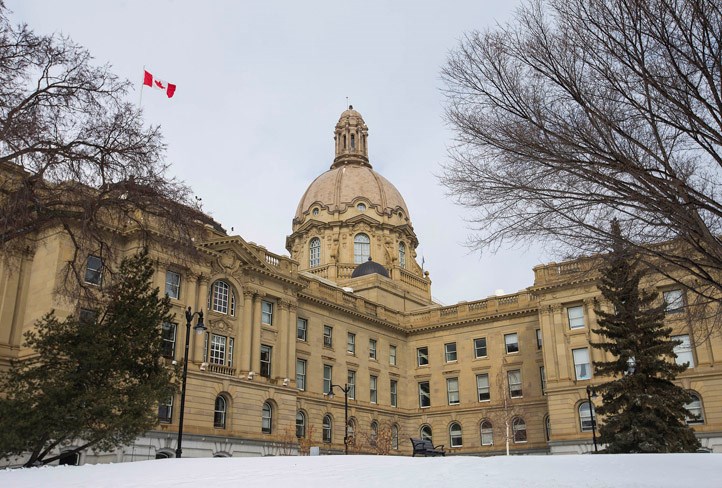St. Albert public school officials are happy that the provincial budget included funding for a replacement of one of its high schools.
Currently Paul Kane High School has 1,036 students and the provincial announcement Friday morning will increase capacity to 1,500.
The news came one day after the provincial government tabled its 2018 budget, which outlined a path to a balanced budget by 2023. By then the province will be $96 billion in debt and debt-servicing costs will soar to more than $3 billion for that year.
Balancing the books will rely heavily on pipeline construction proceeding and the document doesn’t offer any news for municipalities in regards to provincial funding for cannabis.
The St. Albert school is one of 20 school projects receiving money from the provincial government and Sheri Wright, vice chair of the school board, said that the need for high school spaces in the public district is urgent.
“We are very glad to hear. We have been waiting and hoping since we identified the need for a new high school some time ago,” Wright said.
The funding and construction details for Paul Kane still need to be worked out. The current school was built in the 1970s. The replacement school will be constructed near the current school in the area that currently is home to the sports fields. Once the new school is up the old one will be torn down.
The recent school announcement is one of two phases that the local district highlighted in their capital plan that is needed to accommodate upcoming high school students. With the news of the school funding the district is still short seats for high school students and they are hoping to receive future funding for an expansion to Bellerose high school.
The public school district has seen 30 per cent growth in the Kindergarten to Grade 9 population in the last five years.
A Recovery Built to Last
Funding for new schools was highlighted in the NDP government’s fourth budget, titled A Recovery Built to Last, which was tabled on Thursday afternoon.For the first time in four years the budget included a section that outlined a path to balanced books and Finance Minister Joe Ceci said that the chapter was included because Albertans had been asking for more details on the government’s path to balance.
“This is something Albertans have been asking for and we have been promising to show them. We can get to balance and we will do so in five years but we won’t do that at the expense of their programs and services,” Ceci said.
Ceci said that the chapter was not included to appease credit rating agencies, although the province has seen several credit downgrades after previous budgets due to a lack of a detailed plan back to balance.
Debt and deficit
This year the province will run a deficit of $8.8 billion with revenues clocking in at $47.9 billion, which is up by $1 billion from last year’s forecast. Expenses will hit $56.2 billion, which is up by $300 million. A $500 million risk adjustment fund has been included in the balance sheet.Total debt sits at $54.2 billion in 2018.
Alberta has projected the deficit to hit $7.9 billion in 2019-20 followed by $7 billion in 2020-21 on the way to a $700 million surplus in 2023-2024. By the time the books balance the annual debt servicing costs will soar to $3.7 billion.
The government will begin to move revenue from the carbon levy into the general revenue stream by 2021, which will help to balance the books. Originally the NDP said they would only use the money to fund green projects and diversification but proceeds from the funds will be redirected when the levy goes to $50 per tonne in 2021.
Although there is a clear path to balance, the plan relies heavily on two unapproved pipelines being constructed.
Budget 2018 numbers and projections are all banking on the Line 3 and Trans-Mountain pipelines being constructed and the government provided no alternative projections or contingency plans in the case that the pipelines do not see shovels in the ground. The budget projects that both pipelines will be fully operational by 2021.
Oil prices continue to recover slowly and this year prices are being pegged at $59 per barrel. By 2020-21 the province anticipates prices to hit $63.
Cannabis
Budget 2018 is the first time the government is accounting for marijuana revenue but so far no money has been earmarked for municipalities.Alberta is anticipating cannabis costs will be in the red until 2020-21, when the province expects to make $37 million off the new industry. In the first two years the province expects the legalization of the drug to cost $90 million.
On Thursday afternoon it was announced that the federal government is collecting an additional 10 per cent tax on marijuana on behalf of the provincial government in lieu of a provincial sales tax. The money will be distributed to the province after collection.
Ceci said the reason for this additional tax on cannabis is to help ensure the price of marijuana is consistent across Canadian provinces.
AGLC will be able to collect a markup on the distribution of marijuana through online sales but is limited to covering the costs of AGLC’s cannabis operations and a “reasonable profit margin.”
In 2017 it was announced that the federal government would be collecting one dollar per gram on cannabis and 75 per cent of that revenue would be given to the provinces.
In February, Alberta urban municipalities asked the provincial government for 70 per cent of the provincial tax money from marijuana and $30 million from the 2018-2019 provincial budget to handle one-time costs incurred by municipalities related to the legalization of the drug.
The budget included no funding commitments to the provinces for the start-up costs and Ceci said they are still in discussions with the municipalities to sort out how much tax money they will receive.




